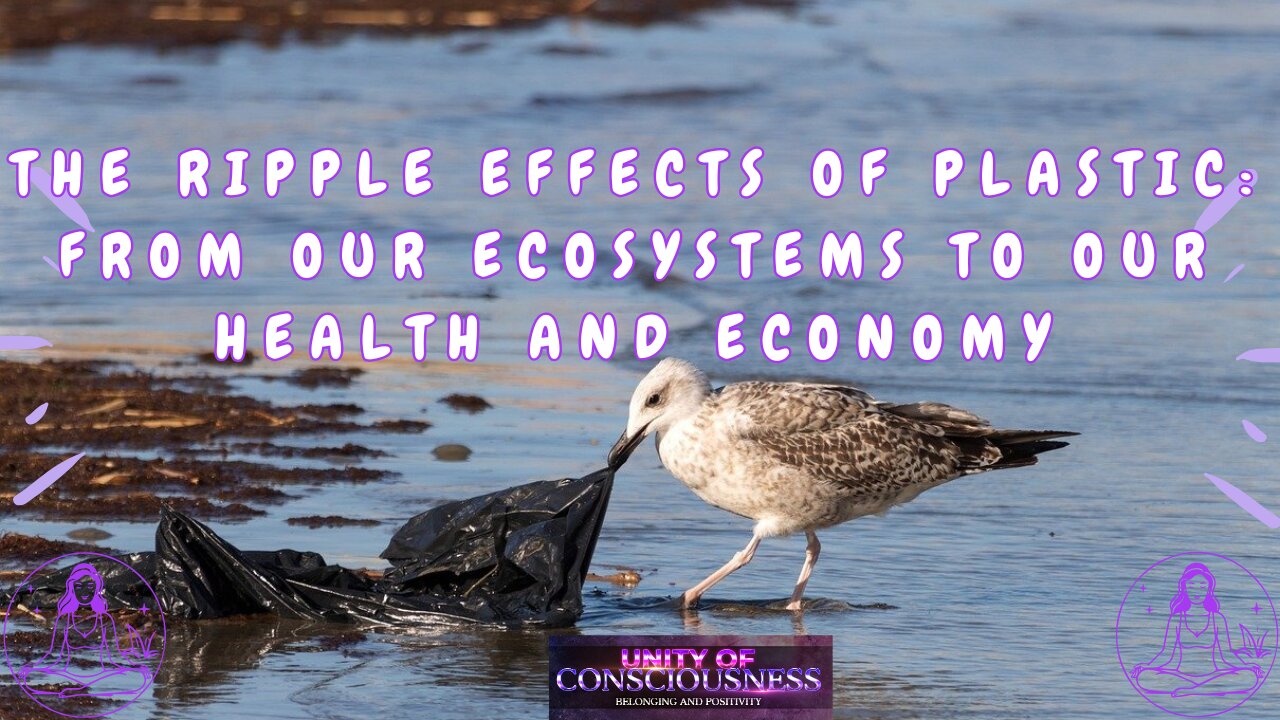Premium Only Content

The Ripple Effects of Plastic From Our Ecosystems to Our Health and Economy
#EconomyofPlastic #PlasticHealthRisks #PlasticAwareness
@unityofconsciousness475
Hi There
- You are made of: GREATNESS, PURE LOVE & LIGHT
Plastics touch every part of our lives, but their impact runs deeper than convenience. They compromise ecosystems, endanger marine and land species, and infiltrate our bodies, affecting our health and well-being. The financial costs are just as severe, straining economies globally, especially in the USA and Australia, while individuals bear hidden costs too. Join us to explore the full scope of plastics' consequences on nature, health, and finances, urging us to consider more sustainable choices.
--Unity of Consciousness is a YouTube channel dedicated to providing a serene and calming experience through meditation and relaxation music; wisdom for well-known spiritual people, and everyday people with their mission in finding happiness. Our channel offers a wide range of soothing melodies and compositions designed to help you unwind, de-stress, and find inner peace. We also, have dedicated ourselves to find you the best tips and experiences for happiness and spiritual growth.
--Please follow us on our channels for more relaxation music & more
- https://www.youtube.com/@unityofconsciousness475?sub_confirmation=1
-https://rumble.com/c/c-1451613
----Disclaimers:
Video is made by Unity of Consciousness via Fliki
-Text: Unity of Consciousness
-Music from Youtube Library
--References for shorts: In the Comments
References
• Jambeck, J. R., et al. (2015). Plastic waste inputs from land into the ocean. Science, 347(6223), 768-771.
• Rochman, C. M. (2016). Microplastics research—from sink to source. Science, 352(6290), 1177-1178.
• Gall, S. C., & Thompson, R. C. (2015). The impact of debris on marine life. Marine Pollution Bulletin, 92(1-2), 170-179.
• Geyer, R., Jambeck, J. R., & Law, K. L. (2017). Production, use, and fate of all plastics ever made. Science Advances, 3(7), e1700782.
• Browne, M. A., et al. (2011). Accumulation of microplastic on shorelines worldwide: sources and sinks. Environmental Science & Technology, 45(21), 9175-9179.
• Galloway, T.S., & Lewis, C.N. (2016). Marine microplastics spell big problems for future generations. Proceedings of the National Academy of Sciences, 113(9), 2331–2333.
• Thompson, R.C., et al. (2004). Lost at Sea: Where Is All the Plastic? Science, 304(5672), 838.
• Lusher, A.L., et al. (2017). Microplastics in fisheries and aquaculture: status of knowledge on their occurrence and implications for aquatic organisms and food safety. FAO Fisheries and Aquaculture Technical Paper.
• Li, J., et al. (2018). Microplastics in freshwater systems: A review on occurrence, environmental effects, and methods for microplastics detection. Water Research, 137, 362-374.
• UNEP (2016). Marine plastic debris and microplastics – Global lessons and research to inspire action and guide policy change. United Nations Environment Programme.
• Geyer, R., Jambeck, J. R., & Law, K. L. (2017). Production, use, and fate of all plastics ever made. Science Advances, 3(7), e1700782.
• United Nations Environment Programme (UNEP). (2018). Single-use plastics: A roadmap for sustainability.
• Hopewell, J., Dvorak, R., & Kosior, E. (2009). Plastics recycling: challenges and opportunities. Philosophical Transactions of the Royal Society B: Biological Sciences, 364(1526), 2115-2126.
• The Ocean Conservancy and McKinsey Center for Business and Environment. (2015). Stemming the Tide: Land-based strategies for a plastic-free ocean.
• Jambeck, J. R., et al. (2015). Plastic waste inputs from land into the ocean. Science, 347(6223), 768-771.
--All rights reserved to: Unity of Consciousness
-Eternally Thankful
-If you are inspired, please subscribe, like and share
-
 LIVE
LIVE
UNITY OF CONSCIOUSNESS
13 days ago $0.19 earnedFor Every Tender Piece of Jazz; There will be a Soul that is Nourished & Nurtured; Relax & Enjoy
3 watching -
 7:51:03
7:51:03
GuardianRUBY
8 hours agoRumble Takeover! The Rumblings are strong
61.8K2 -
 4:28:45
4:28:45
Etheraeon
15 hours agoWorld of Warcraft: Classic | Fresh Level 1 Druid | 500 Follower Goal
45.5K -
 3:17:21
3:17:21
VapinGamers
8 hours ago $3.60 earned🎮🔥Scrollin’ and Trollin’: ESO Adventures Unleashed!
31.2K2 -
 LIVE
LIVE
a12cat34dog
9 hours agoGETTING AFTERMATH COMPLETED :: Call of Duty: Black Ops 6 :: ZOMBIES CAMO GRIND w/Bubba {18+}
320 watching -
 8:23:18
8:23:18
NubesALot
11 hours ago $5.12 earnedDark Souls Remastered and party games
27.9K -
 3:03:42
3:03:42
GamersErr0r
23 hours ago $2.14 earnedits not what you think
22.9K1 -
 7:15:50
7:15:50
Phyxicx
9 hours agoRocket League with Friends! - 11/22/2024
17.1K1 -
 7:54:29
7:54:29
STARM1X16
10 hours agoFriday Night Fortnite
14.3K -
 29:51
29:51
Afshin Rattansi's Going Underground
1 day agoJimmy Dore on Ukraine & WW3: Biden Wants a War that Trump CAN’T Stop, ONLY Hope is Putin’s Restraint
72.2K32